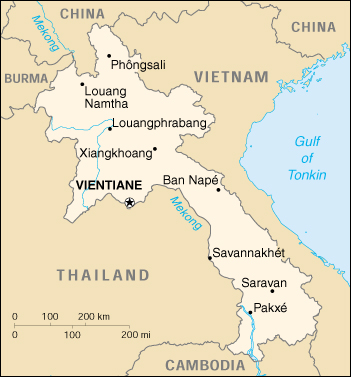

Capital: Vientiane
Administrative divisions: 16 provinces (khoueng, singular and
plural), 1 municipality* (kampheng nakhon, singular and
plural), and 1 special zone** (khetphiset, singular and plural); Attapu,
Bokeo, Bolikhamxai, Champasak, Houaphan,
Khammouan, Louangnamtha, Louangphabang, Oudomxai, Phongsali, Salavan,
Savannakhet, Viangchan*, Viangchan,
Xaignabouli, Xaisomboun**, Xekong, Xiangkhoang
Climate: tropical monsoon; rainy season (May to November); dry season (December to April)
Terrain: mostly rugged mountains; some plains and plateaus
Elevation extremes:
lowest point: Mekong River 70 m
highest point: Phou Bia 2,817 m
Natural resources: timber, hydropower, gypsum, tin, gold, gemstones
Irrigated land: 1,250 sq km (1993 est.)
note: rainy season irrigation - 2,169 sq km; dry season irrigation
- 750 sq km (1998 est.)
Natural hazards: floods, droughts, and blight
Environment - current issues: unexploded ordnance; deforestation;
soil erosion; a majority of the population does not have
access to potable water
Sex ratio:
at birth: 1.05 male(s)/female
under 15 years: 1.02 male(s)/female
15-64 years: 0.97 male(s)/female
65 years and over: 0.85 male(s)/female
total population: 0.98 male(s)/female (2000 est.)
Infant mortality rate: 94.8 deaths/1,000 live births (2000 est.)
Nationality:
noun: Lao(s) or Laotian(s)
adjective: Lao or Laotian
Ethnic groups: Lao Loum (lowland) 68%, Lao Theung (upland) 22%,
Lao Soung (highland) including the Hmong ("Meo")
and the Yao (Mien) 9%, ethnic Vietnamese/Chinese 1%
Religions: Buddhist 60% (in October 1999, the regime proposed
a constitutional amendment making Buddhism the state
religion; the National Assembly is expected to vote on the amendment
sometime in 2000), animist and other 40%
Languages: Lao (official), French, English, and various ethnic languages
Literacy:
definition: age 15 and over can read and write
total population: 57%
male: 70%
female: 44% (1999 est.)
